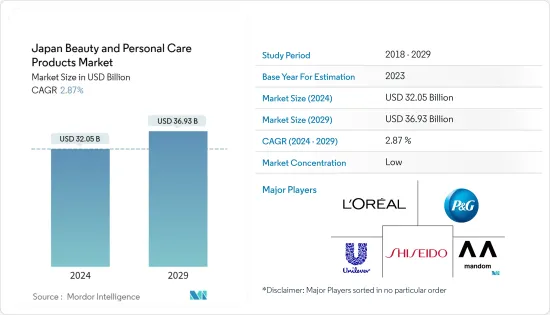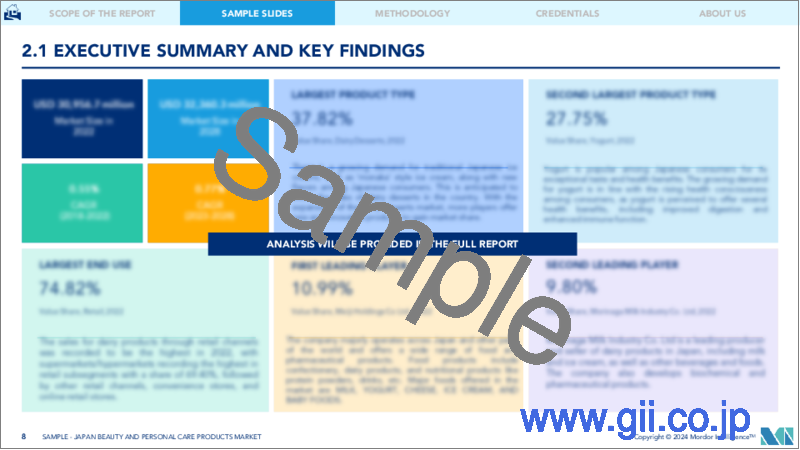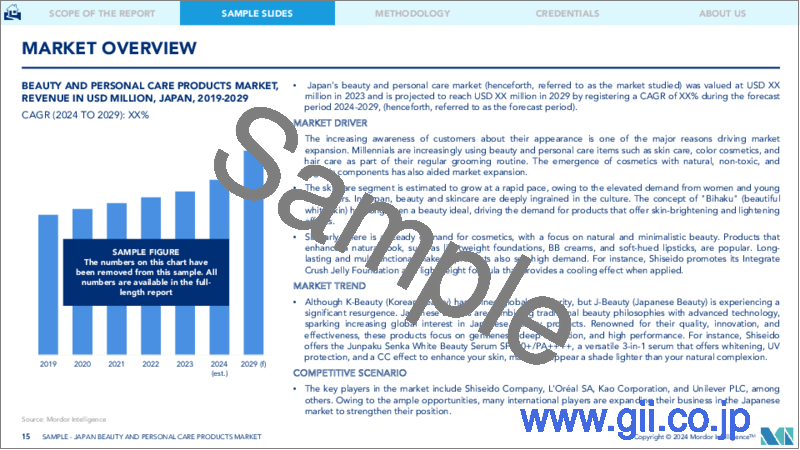|
|
市場調査レポート
商品コード
1441694
日本の美容・パーソナルケア製品市場:市場シェア分析、業界動向と統計、成長予測(2024-2029年)Japan Beauty and Personal Care Products - Market Share Analysis, Industry Trends & Statistics, Growth Forecasts (2024 - 2029) |
||||||
カスタマイズ可能
適宜更新あり
|
|||||||
| 日本の美容・パーソナルケア製品市場:市場シェア分析、業界動向と統計、成長予測(2024-2029年) |
|
出版日: 2024年02月15日
発行: Mordor Intelligence
ページ情報: 英文 80 Pages
納期: 2~3営業日
|
全表示
- 概要
- 目次
日本の美容・パーソナルケア製品市場規模は、2024年に320億5,000万米ドルと推定され、2029年までに369億3,000万米ドルに達すると予測されており、予測期間(2024年から2029年)中に2.87%のCAGRで成長します。

日本は世界最大の化粧品・パーソナルケア製品市場の一つです。日本の消費者はヘア製品の化学配合に関して非常に洗練されており、十分な知識を持っています。天然成分とオーガニック配合物は市場で高い需要を示しており、主要メーカーはナチュラル/クリーン製品ラベルを付けた製品を発売するようになっています。日本の消費者に人気の商品は、高機能製品、即効性のあるスキンケア製品、複数の魅力を備えたクロスオーバー製品です。日本の消費者は、スキンケア製品を含む化粧品に対する一人当たりの支出額が最も高く、これが日本の美容・パーソナルケア製品市場の成長を促進しています。
さらに、Amazon、楽天、Yahooなどのオンライン流通チャネルやeコマースWebサイト、および多くのローカルWebサイトの浸透の高まりにより、消費者の注目を集める複数の化粧品やパーソナルケアのオプションが提供されています。日本ではスキンケアの革新が継続的に起こっています。市場関係者は、パーソナライズされた美容製品のための技術を革新しています。たとえば、AS Watson Groupは2022年 10月に、顧客の自撮り写真に基づいて高度にパーソナライズされたスキンケア製品の推奨を作成する革新的な肌分析ツール「SkinlifeLab」を立ち上げました。
日本の美容・パーソナルケア製品市場動向
自然派化粧品とスキンケア製品の需要の高まり
日本ではここ数年、ナチュラルスキンケア製品の需要が大幅に増加しています。化粧品やスキンケア製品における天然成分の使用に対する消費者の関心の高まりにより、さまざまな製品革新が生まれています。これらの天然成分の利点が認識され、変化する顧客の要求に応えるために活用されています。ユニリーバ、資生堂などの企業は、顧客向けに新製品を生み出すために迅速な研究開発を行っています。 2021年6月、資生堂はサステナブルスキンケアブランド「Baum」を日本に導入しました。同社は、このブランドの製品の配合成分の90%が樹木由来であることを示唆しました。eコマースの発展も、この地域の化粧品市場が成長する理由の1つです。 Amazon、楽天、Yahoo、LahacoなどのEコマースサイトでは、さまざまなブランドのオーガニック化粧品が販売されています。このため、消費者は化粧品の選択肢を得ることができます。
広告やプロモーションに多額の費用がかかる
日本企業は自社製品の広告やプロモーションに非常に積極的です。市場関係者は、競合に勝ち残り、消費者の注目を集めるために、自社の製品を積極的かつ精力的に宣伝しています。日本では、Instagram、Youtube、Facebook、TikTok、Twitter、Lineなどのソーシャルメディアプラットフォームを使用する若者が多くいます。企業はこれらのプラットフォームを通じて化粧品やその他の美容製品を宣伝し、消費者の注目を集めています。テレビや新聞などの従来の広告媒体も使用されます。電通が発表した2021年の日本の広告費報告書によると、化粧品の広告費は5.3%増加し、広告費全体の9.7%を占めました。報告書によると、女性向け化粧品、歯ブラシ、メイク落としの広告が過去5年間で増加しています。
日本の美容・パーソナルケア製品業界の概要
日本の美容・パーソナルケア製品市場は競争の激しい市場です。市場は細分化されており、多数の世界およびローカルの企業によって主導されています。主要企業は、消費者に革新的な製品を提供するための絶え間ない努力により、国内市場を積極的に牽引しています。活発な企業が採用する戦略には、製品の発売に続いて、国内市場で大きなシェアを保持するために小規模な企業を買収することが含まれます。
その他の特典
- エクセル形式の市場予測(ME)シート
- 3か月のアナリストサポート
目次
第1章 イントロダクション
- 調査の前提条件と市場の定義
- 調査範囲
第2章 調査手法
第3章 エグゼクティブサマリー
第4章 市場力学
- 市場促進要因
- 市場抑制要因
- ポーターのファイブフォース分析
- 新規参入業者の脅威
- 買い手の交渉力
- 供給企業の交渉力
- 代替製品の脅威
- 競争企業間の敵対関係の激しさ
第5章 市場セグメンテーション
- 製品タイプ別
- パーソナルケア
- ヘアケア
- スキンケア
- バス・シャワー
- オーラルケア
- 男性用グルーミング製品
- デオドラント・制汗剤
- 化粧品/メイクアップ製品
- カラーコスメ
- パーソナルケア
- カテゴリー別
- プレミアム
- 量産
- 流通チャネル別
- 専門小売店
- スーパーマーケット/ハイパーマーケット
- コンビニエンスストア
- 薬局/ドラッグストア
- オンライン小売チャネル
- その他
第6章 競合情勢
- 最も採用されている戦略
- 市場シェア分析
- 企業プロファイル
- Unilever PLC
- Procter &Gamble Co
- Kao Corporation
- Mandom Corporation
- Lion Corporation
- Shiseido Company
- L'Oreal SA
- AS Watson Group
- SK-II
- Makanai
第7章 市場機会と将来の動向
The Japan Beauty and Personal Care Products Market size is estimated at USD 32.05 billion in 2024, and is expected to reach USD 36.93 billion by 2029, growing at a CAGR of 2.87% during the forecast period (2024-2029).

Japan is one of the largest markets for cosmetics and personal care products globally. Japanese consumers are extremely sophisticated and well-informed regarding the chemical formulations in hair products. Natural ingredients and organic formulations are witnessing high demand in the market, which is driving key manufacturers to launch products with natural/clean product labels. Popular items for Japanese consumers are high-performance products, quick-acting skincare products, and crossover products with multi-appeal attributes. Japanese consumers have the highest per capita expenditure on cosmetics, including skin care products, which is boosting the growth of the beauty and personal care market in the country.
Furthermore, the rise in penetration of online distribution channels and e-commerce websites like Amazon, Rakuten, Yahoo, and many local websites provide multiple cosmetics and personal care options that grab the attention of consumers. The development of skincare innovations is continuously happening in Japan. The market players are innovating technologies for personalized beauty products. For instance, in October 2022, the AS Watson Group launched "SkinlifeLab," an innovative skin analysis tool that creates highly personalized skincare product recommendations based on customers' selfies.
Japanese Beauty and Personal Care Products Market Trends
Rising Demand for Natural Cosmetics and Skincare Products
The demand for natural skin care products has increased significantly in the past few years in Japan. The growing interest of consumers in the use of natural ingredients in cosmetics and skin care products has led to various product innovations. The benefits that these natural ingredients have has been recognized and utilized to cater to changing customer demands. Companies like Unilever, Shiseido, and many others are functional with their prompt research and development to create new products for customers. In June 2021, Shiseido introduced a sustainable skincare brand named Baum in Japan. The company suggested that 90% of the formula for the products of this brand was derived from trees. The development of e-commerce is also one of the reasons for the cosmetic market's growth in the region. Different brands of organic cosmetics are available on e-commerce websites like Amazon, Rakuten, Yahoo, Lahaco, and many more. Because of this, consumers can get options for cosmetic products.
High Expenditure on Advertising and Promotions
Japanese companies are very much active when it comes to the advertising and promotions of their products. The market players are actively and vigorously advertising their products to stay in the competition and grab consumer attention. Japan has a high number of young people who uses social media platforms like Instagram, Youtube, Facebook, TikTok, Twitter, Line, and many more. The companies promote cosmetics and other beauty products via these platforms and gain consumer attention. Traditional advertising media like television and newspapers are also used. According to Dentsu Inc.'s report of advertising expenses in Japan from 2021, cosmetics advertising expenses increased by 5.3% and accounted for 9.7% of the total advertising expenditure. According to the report, advertising of cosmetics for women, toothbrushes, and makeup removers has increased in the last five years.
Japanese Beauty and Personal Care Products Industry Overview
The beauty and personal care market in Japan is a highly competitive market. The market is fragmented and led by numerous global and local players. The major players, such as Shiseido company, Mandom Corporation, Loreal, Procter and Gamble, Unilever, and others, are actively driving the market in the nation with their constant efforts to provide consumers with innovative products. The strategies adopted by active companies include product launches, followed by the acquisition of small players so as to hold a major share of the market in the country.
Additional Benefits:
- The market estimate (ME) sheet in Excel format
- 3 months of analyst support
TABLE OF CONTENTS
1 INTRODUCTION
- 1.1 Study Assumptions and Market Definitions
- 1.2 Scope of the Study
2 RESEARCH METHODOLOGY
3 EXECUTIVE SUMMARY
4 MARKET DYNAMICS
- 4.1 Market Drivers
- 4.2 Market Restraints
- 4.3 Porter's Five Forces Analysis
- 4.3.1 Threat of New Entrants
- 4.3.2 Bargaining Power of Buyers/Consumers
- 4.3.3 Bargaining Power of Suppliers
- 4.3.4 Threat of Substitute Products
- 4.3.5 Intensity of Competitive Rivalry
5 MARKET SEGMENTATION
- 5.1 By Product Type
- 5.1.1 Personal Care
- 5.1.1.1 Hair Care
- 5.1.1.1.1 Shampoo
- 5.1.1.1.2 Conditioners
- 5.1.1.1.3 Other Products
- 5.1.1.2 Skin Care
- 5.1.1.2.1 Facial Care Products
- 5.1.1.2.2 Body Care Products
- 5.1.1.2.3 Lip Care Products
- 5.1.1.3 Bath and Shower
- 5.1.1.3.1 Shower Gels
- 5.1.1.3.2 Soaps
- 5.1.1.3.3 Other Products
- 5.1.1.4 Oral Care
- 5.1.1.4.1 Toothbrushes
- 5.1.1.4.2 Toothpaste
- 5.1.1.4.3 Mouthwashes and Rinses
- 5.1.1.4.4 Other Products
- 5.1.1.5 Men's Grooming Products
- 5.1.1.6 Deodrants and Antiperspirants
- 5.1.2 Cosmetics/Make-up Products
- 5.1.2.1 Colour Cosmetics
- 5.1.2.1.1 Facial Make-up Products
- 5.1.2.1.2 Eye Make-up Products
- 5.1.2.1.3 Lip and Nail Make-up Products
- 5.1.2.1.4 Hair Styling and Coloring Products
- 5.1.1 Personal Care
- 5.2 By Category
- 5.2.1 Premium Products
- 5.2.2 Mass Products
- 5.3 By Distribution Channel
- 5.3.1 Specialist Retail Stores
- 5.3.2 Supermarkets/Hypermarkets
- 5.3.3 Convenience Stores
- 5.3.4 Pharmacies/Drug Stores
- 5.3.5 Online Retail Channels
- 5.3.6 Other Distribution Channels
6 COMPETITIVE LANDSCAPE
- 6.1 Most Adopted Strategies
- 6.2 Market Share Analysis
- 6.3 Company Profiles
- 6.3.1 Unilever PLC
- 6.3.2 Procter & Gamble Co
- 6.3.3 Kao Corporation
- 6.3.4 Mandom Corporation
- 6.3.5 Lion Corporation
- 6.3.6 Shiseido Company
- 6.3.7 L'Oreal SA
- 6.3.8 AS Watson Group
- 6.3.9 SK-II
- 6.3.10 Makanai





